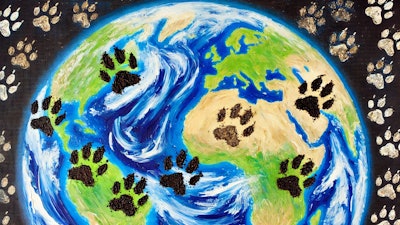
The potential for sustainability projects in the pet food industry is as diverse as definitions for the term “sustainable.” While multinationals may be able to go waste-free and 100% solar, sustainable can be attainable for even mom-and-pop pet food start-ups by taking advantage of local opportunities. Like the old environmental adage to think globally and act locally, partnering with local environmental and social groups offers several benefits to pet food companies, especially smaller brands. By connecting with local do-gooders, brands earn their community’s goodwill, access local knowledge and skills, and can give employees a chance to participate in grassroots efforts. Such partnerships can include habitat restoration, wildlife conservation and community food gardens. Likewise, social sustainability efforts can involve supporting marginalized or underserved people.
Pet food companies have a wide range of options for sustainability projects, since the concept is so expansive. The United Nations Brundtland Commission defined sustainability as “meeting the needs of the present without compromising the ability of future generations to meet their own needs.” Since 1987, sustainability has grown to include various specific environmental, social and economic issues. Numerous problems, ranging from existential threats to minor annoyances, now fall into a common sustainability bin. However, halting the razing of the Amazon rainforest presents far different challenges from raising Amazon.com employees’ working conditions. At the same time, businesses must maintain their financial viability while balancing environmental and social elements to attain economic sustainability.
Leveraging Pet Owners’ Affinity for Animals
Within their region, pet food companies can often find a range of potential partners for sustainability initiatives. Collaborating with local conservation groups may resonate with pet owners, who tend to be more concerned about animal welfare than the general public.
Pet owners have a natural love for their pets, which may extend to broader concerns about animals and wildlife. This connection allows pet food companies to engage with customers by supporting causes that protect wildlife, especially charismatic or endangered species, and their habitats.
Pet owners who invest in the health and happiness of their dogs, cats, and other pets may be more likely to support brands that align with their values related to animals in general. Collaborations with conservation groups can highlight a company’s dedication to animal well-being, reinforcing consumer loyalty and trust.
How collaborating with conservation groups benefits pet food companies
1. Strengthening Brand Identity Through Shared Values
Working with conservation organizations enables pet food companies to demonstrate a commitment to wildlife and environmental protection, aligning their brand with values that matter to their customers. Whether it's supporting endangered species or protecting habitats from deforestation, these initiatives can resonate with pet owners who view animal welfare as part of their broader ethical concerns.
For example, although outdoor and feral cats prey on native wild birds, a cat food company could turn this environmental issue on its head and partner with a local conservation group focused on protecting bird habitats. This partnership might include raising awareness about the importance of limiting cats’ opportunities to kill wildlife. The brand could share its story of caring for both pets and wild species.
2. Building Community Connections and Local Impact
Collaborations with local conservation groups can create meaningful community engagement and subsequent local support for a brand. Pet food companies can directly support regional initiatives that protect local wildlife, such as preserving wetlands, restoring urban green spaces or supporting regenerative agriculture.
For example, a pet food company based in a region known for its fisheries might collaborate with a marine conservation organization to promote sustainable fishing practices. This could involve supporting initiatives that protect fish populations, educating consumers about responsible seafood sourcing, and ensuring that ingredients used in their products come from sustainable sources.
3. Raising Awareness and Educating Pet Owners
Working with conservation groups can potentially educate pet owners about the interconnectedness of ecosystems, animal welfare and sustainable agricultural practices. Pet food companies can actively spread awareness about how certain practices, such as sustainable sourcing of proteins or using eco-friendly packaging, help reduce humanity’s environmental impact.
Companies can work alongside conservation groups to create educational campaigns informing pet owners about their purchasing decisions' broader impact. For instance, companies could highlight how responsible ingredient sourcing supports wildlife conservation efforts or how habitat restoration projects help protect species that could otherwise be at risk. These narratives deepen the connection between the brand, its customers, and its conservation efforts.
Pet food companies act locally for global benefits
Collaborating with local conservation and environmental groups can address specific issues relevant to an area, such as biodiversity loss, water conservation, climate change and deforestation. All of these efforts directly affect regional ecosystems that pet owners see in their regions.
When pet food companies show they care about the environment that pet owners, pets and their wild cousins live in, those brands can develop bonds with pet owners who feel a similar sense of responsibility toward nature.
Collaboration between pet food companies and local conservation groups offers a win-win situation: wildlife benefits from protection and preservation efforts, and companies gain the trust and loyalty of environmentally conscious consumers in their own backyards. By aligning with the values of pet owners, many of whom are passionate about animal welfare beyond their own pets, pet food professionals can live up to their own sustainability ideals.

















